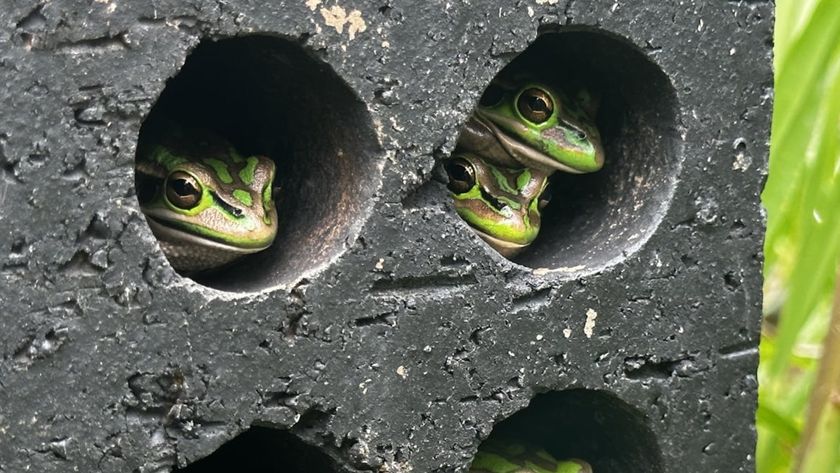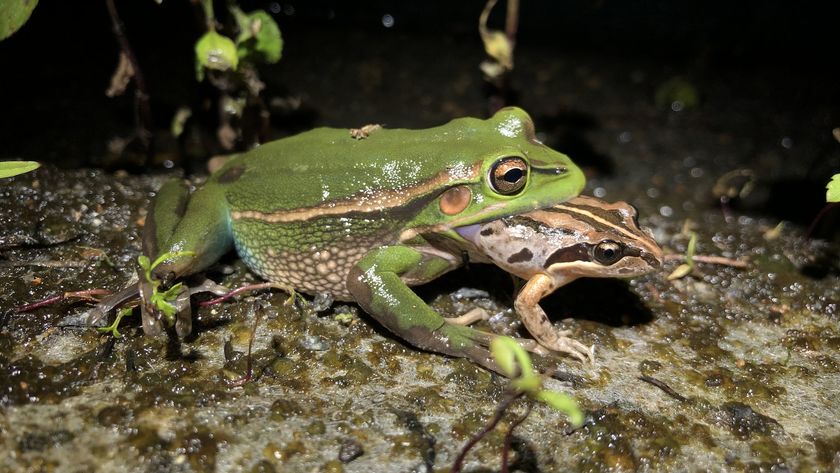Cannibal Tadpoles Croak When Attacking Kin

When frogs are just teensy tadpoles, they're already croaking like adults, researchers have observed for the first time.
They not only croak when attacked, but when they cannibalistically attack members of their own species as well, scientists find.
Tadpoles, or pollywogs, are frogs in their young larval stages. They dwell entirely in the water and look somewhat like fish.
Frogs are well known for croaking, with each species having its own unique call. Now researchers are discovering that tadpoles can speak up as well (albeit much more softly).
Evolutionary biologist Miguel Vences at the Technical University of Braunschweig in Germany investigated the tadpoles of a frog species from western Madagascar, Gephyromantis azzurrae, which prefers living in cool, shallow, fast streams. These pollywogs are carnivores, preying not just on insect larvae and shrimp, but also on tadpoles of the same and other species.
Vences and his colleagues found these predator tadpoles called out while attacking prey by making rapid clicks, perhaps by snapping the hard sheaths over their jaws together. They called out significantly more often when they were hungry or when attacking tadpoles of the same species.
Most animal sounds, such as in birds, frogs and crickets, "are produced in the context of reproduction and therefore by adult animals, usually males," Vences said. "It is very rare that young animals and especially larvae are producing sounds, except maybe in birds, where of course the young are known to chirp as loud as the adults."
Sign up for the Live Science daily newsletter now
Get the world’s most fascinating discoveries delivered straight to your inbox.
Traveling tadpoles
The researchers actually initially discovered these tadpoles could make clicks in 1994.
"Almost 20 years ago, [taxonomist] Frank Glaw and I found them for the first time and suddenly realized that faint sounds were coming out of the bucket were we were keeping them," Vences told LiveScience.
Vences and Glaw, of the Bavarian State Collection of Zoology in Germany, found the tadpoles in the Isalo region and were struck by their unusual color and massive jaw sheaths. The pair decided to bring them back to Madagascar's capital Antananarivo where they could observe them.
"At the time, we had no money to rent [our] own car and had to travel with public transport, which in Madagascar is a real challenge, and in that year, there was a really bad hurricane striking the island," Vences said.
"So, there we were, traveling for more than three days in extremely overcrowded minibuses and cars, over roads partly destroyed by landslides, and all the time with a large bucket full of water and with some of these tadpoles on our knees," he added.
On more than one occasion, the pair contemplated throwing the tadpoles into a ditch to make their ride more comfortable – but they didn't.
"Then we had to wait over 15 years until we found some students interested in tadpoles and who would invest the effort to sit for many, many hours in front of a little aquarium with a video camera and special microphones to record these sounds and monitor the tadpole behavior," Vences said. "A very painstaking job, and [biologist] Erik Reeve really was exceptional in getting this system to work. Consider that these tadpoles are tiny and the sounds very faint — without a special microphone and amplifier, you can just barely hear them if your ear is very close to the aquarium."
What are the tadpoles saying?
The experiments showed that smaller tadpoles made fewer calls and were less likely than the big guys to use a combination of different call types, suggesting the sound of the clicks might yield clues about the size of the tadpoles making them. They might be used to chase away other members of their own species, the scientists speculated. Their findings will be detailed in an upcoming issue of the journal Naturwissenschaften. [Read about tadpoles with three eyes.]
Tadpoles of another frog species were also revealed earlier this year as capable of calling out — the South American horned frog Ceratophrys ornata. However, they mostly sounded off when attacked, emitting brief, clear metallic notes by pushing air out their lungs when tadpoles of their own species attacked them. These distress calls might prevent the tadpoles from cannibalizing each other.
"I find communication a marvelous thing, in nature, modern society, art expressions, technological development, and its evolution towards complex adaptive systems," said herpetologist Guillermo Natale at the National University of La Plata at Buenos Aires. He and his colleagues detailed their findings regarding South American horned frog tadpoles online Feb. 26 in the journal Acta Zoologica.
When it comes to future research into tadpole calls, "we need additional experiments showing that the tadpoles actually hear these sounds and alter their behavior accordingly — that is, they escape when they hear the sounds even if there is no one attacking them, or they become themselves more aggressive when hearing such sounds around them," Vences said.
Vences suggested that additional research on tadpoles could help better understand amphibian ecology and evolution.
"In Madagascar, we are realizing only now how diverse in morphology and feeding modes these larvae are, with extremely different oral structures and some of them now apparently even with, albeit simple, systems of acoustic communication," Vences said. The true depth of specialization and competition in frogs, which is "important to explain their extraordinary diversity in the tropics, may well take place at this level rather [than] at the level of adults."












